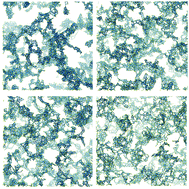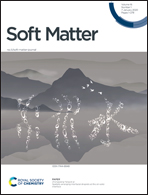Computer simulations of colloidal gels: how hindered particle rotation affects structure and rheology
Abstract
The effects of particle roughness and short-ranged non-central forces on colloidal gels are studied using computer simulations in which particles experience a sinusoidal variation in energy as they rotate. The number of minima n and energy scale K are the key parameters; for large K and n, particle rotation is strongly hindered, but for small K and n particle rotation is nearly free. A series of systems are simulated and characterized using fractal dimensions, structure factors, coordination number distributions, bond-angle distributions and linear rheology. When particles rotate easily, clusters restructure to favor dense packings. This leads to longer gelation times and gels with strand-like morphology. The elastic moduli of such gels scale as G′ ∝ ω0.5 at high shear frequencies ω. In contrast, hindered particle rotation inhibits restructuring and leads to rapid gelation and diffuse morphology. Such gels are stiffer, with G′ ∝ ω0.35. The viscous moduli G′′ in the low-barrier and high-barrier regimes scale according to exponents 0.53 and 0.5, respectively. The crossover frequency between elastic and viscous behaviors generally increases with the barrier to rotation. These findings agree qualitatively with some recent experiments on heterogeneously-surface particles and with studies of DLCA-type gels and gels of smooth spheres.



 Please wait while we load your content...
Please wait while we load your content...